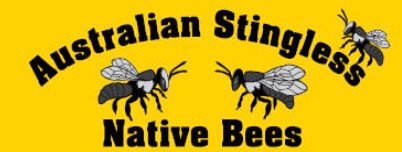The Dreaded Cadagi Tree
Botanical name – Corymbia torreliana
This rainforest tree from North Queensland was used extensively in the 70’s and 80’s as a fast growing attractive shade tree in South East Queensland. It has an attractive shape and broad fury leaves. New leaves commence as red tips which make it pleasant to look at. The large flowers open in November, and appear to be well visited by the Native Bees. It is a valuable tree as far as food is concerned.
After pollination, the seedpods develop and begin to open in early January and continue to mature until the end of February. This is a serious period of time for the bees!! The native bees visit the opened seedpods to collect the resin that exudes from the seeds. The resin is mixed with native bee wax to be used as nest building and sealing material.
The Trigona carbonaria species are obsessed with this collection of resin. As the resin is attached to the seed, thousands of seeds are carried home by the bees. The little bee will be seen carrying two seeds home on their back legs. This is extraordinary, as each seed is approximately 1½ millimetres diameter.
There are now three (3) major problems.
1. Clogged Entrance
There are literally thousands of seeds carried home. The inside for the box is lined with multiple layers of seeds. At the entrance of the nest, there are so many seeds, that the entrance may become completely clogged. It is a daily ritual to remove the seeds with a screwdriver. A clogged up entrance may prevent air movement and cause overheating, and possible death of the nest. Obviously the bees cannot get in or out either.
2. Overheating and Collapse
The seeds line the inside of the box in multiple layers. The resin is still exuding from the seed. The resin is in such large quantities that the fumes on a hot day may kill the colony. For the 2002 season, we lost 6 colonies due to overheating and fume poisoning.
3. Obsession with Seeds
You should not split or do log transfers during this period. From observation, the bees will continue to collect excessive seeds and resin during this traumatic period. Unfortunately they forget to clean up or guard the hive. It is at this critical period that the hive is most vulnerable to attack by the native fly. You will see the native fly laying eggs all over the joints of the box. The eggs hatch into maggots, and move their way into the hive, where the maggots grow on pollen and honey. Eventually the nest will become infected with 100’s of maggots and quickly destroy the nest. Tape up all joints with tape.
Solutions.
1. Destroy all Cadagi trees within 1 km.
2. Move nests into a non-cadagi area.
3. Do not split or do log transfers during this period
Conclusion.
This is truly a natural obsession. The bees go crazy over the collection of this resin, so that they forget to carry out their normal duties. It is case where a tree uses an insect to distribute its seeds. Amazing, don’t you think!!
PS. Cadagi and Trigona carbonaria do not naturally occur together. We have brought the tree to the bees!!!
Russell & Janine Zabel
3597 Warrego Highway
Hatton Vale
Queensland 4341
Australia
Russell & Janine Zabel
3597 Warrego Highway
Hatton Vale
Queensland 4341
Australia
Get the Buzz
Subscribe to our newsletter



